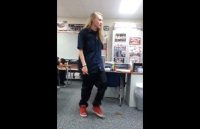The Digital Lives of Teens: Revolutionary “Bliss”?
English novelist and playwright E.G. Bulwer-Lytton once wrote, "A revolution is a transfer of power." We might just be on the brink of a revolution when it comes to kids, technology and schools.
High school student Jeff Bliss' recent, public and viral rant about his teacher has unsettled the minds and hearts of every teacher working with kids right now. At the drop of a hat, a student can go public with dissatisfaction or disgruntlement, unleashing a torrent of response and reprisal.
The sophomore from Duncanville, Texas blasted his world history teacher after being sent out of class. In his widely distributed video rant, he voices: "If you would just get up and teach them instead of handing them a freaking packet, yo. There's kids in here who don't learn like that, they need to learn face-to-face."
Consumers in Control
Bliss has touched on a seismic shift happening in schools across the country. Kids are wanting and demanding more from their education, and their expectations are rubbing up against the traditional power structure of schools, with the teacher in control and the student as a compliant consumer of learning.
The challenge for schools right now is that consumer culture places kids in control. Douglas Rushkoff, in Present Shock: When Everything Happens Now, shares a conversation he had with Kevin Roberts, CEO of Saatchi and Saatchi. Roberts explains the power that young consumers have:
(See page 211 for the full quote.)
Bliss taps into this new dynamic. He is empowered, autonomous, and he has no fear. And he is attempting to wrest control away from the teacher.
When the line between outside and inside of school grows blurred, tension bubbles to the surface and, with the ease and access of a vast Internet audience, kids can voice their demands, as Bliss has done. What's unnerving for educators is that student dissatisfaction or questioning of the way things are done can so quickly become public. Schools then find themselves in reactive mode and on the defensive, instead of leaning into the changes that are already happening and trying to figure out ways to understand these shifting social changes catalyzed by the explosive growth of technology.
Students live in a consumer culture outside of school, mixing, mashing and sharing content, whether it's video or music, and they have control and choice, through personalization and self-expression on Instagram or Tumblr.
And they have the advantage that in many cases their parents have never been on Instagram or Tumblr, much less understanding what these sites are or can do. Teens' social lives are distributed and flat, and then these same kids enter schools where the social structure is firmly established and rooted in clearly defined, hierarchical roles where the teacher holds power over the student.
But, as Bliss' video hints, this social structure is changing, and that is confusing for schools. The firm ground that educators have stood on for decades is loosening and coming undone with technology, especially as students are demanding more voice and control, as Bliss captures. Kids are pushing for a transfer of power away from having adults dictate the learning mode in the classroom. A revolution is afoot.
Running the Asylum
How can schools understand this revolutionary moment? What is the new social structure as technology finds its way into the hallways, classrooms and lunchrooms?
For starters, schools can draw on the changes in the workplace, which trickle down into universities and school systems. Kevin Kuske, Skipper and Chief Brand Anthropologist for Turnstone, writes in Business News Daily about "the networked age of distributed work." Bliss' statement "[t]here's kids in here who don't learn like that" is essentially a call for "distributed work," or the idea of decentralization of learning, and opening up to the idea that one size does not fit all and there is room for personalization of learning.
Kuske writes: "Co-creation is ascending as the new dominant model of innovation, creativity and differentiation." He outlines several key components of this new model that are relevant for schools: "choice and control, unchain the user and let the inmates run the asylum."
What Bliss is demanding is a voice in his own learning. He wants choice and control and to be able to tell his teacher how he best learns, which clearly is not through a packet. Bliss wants to be "unchained," free to move. And the most daunting thought of all for schools, Bliss wants to "run the asylum."
Kuske explains the idea of the inmates running the asylum: "Recognize that not everyone creates or shares the same way -- some go digital, some love doodling, some love Legos, make sure spaces are available everywhere to support the lightening inspiration."
Viewed in this way, setting students free to roam and learn through different media and modes opens up possibility and is less daunting than flattening the entire social structure of schools. But the social structure is changing, and knowledge is being distributed. Bliss is essentially calling for co-creation. He wants to be heard and valued as a learner.
While his choice of expression, coupled with the fallout for his teacher and school, can and should be addressed, some of his message has value and needs to be reckoned with. He is tapping into a revolutionary moment where a transfer of power is beginning to happen.
